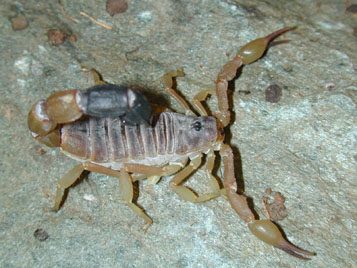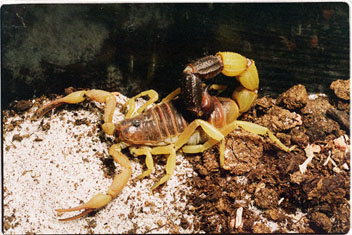Parabuthus liosoma
(Ehrenberg,
1828)
|
|

|

|
Common names:
"African Black Tail Scorpion". This
species is formerly known as P. liosoma, but Fet
et al. (2000) conclude that leiosoma is the
original spelling. Acosta & Fet (2005) changed the name back to P. liosoma.
Distribution:
Africa (Egypt, Ethiopia, Kenya, Somalia, Sudan,
Tanzania). Asia (Saudi Arabia, Yemen).
Habitat:
Arid/semi-arid grassland/savannah. Moderate humidity.
Don't dig burrows, but use natural space/burrows under
stones and other objects.
Venom:
Few medical data available, but probably moderate
venomous. One case is reported from Saudi Arabia by Goyffon & Vachon (1979).
A 50 old female was stung in the toe, and experienced a immediate, persistent pain
in the lower extremities. In the hours after the sting the patient showed arteriell
hypotension, anxiety and agitation. No thermal abnormalities was observed. After
medical treatment of the symptoms (no anti-venom was used!), the general condition
of the patient improved after three hours. The local pain didn't go away until 36 hours
after the sting. No venom squrting ability.
Selected litterature:
Probst, P. J. (1973). "A review of the scorpions of
East Africa with special regards to Kenya and
Tanzania." Acta. Tropica 30(4): 312-335.
Newlands, G. (1974). The venom-squirting ability of Parabuthus
scorpions (Arachnida:Buthidae). South African Journal of
Medical Sciences 39: 175-178.
Goyffon, M. & M. Vachon (1979). Arachnids of Saudi Arabia: Notes on poisoning
accidents through scorpions in Saudi Arabia. Fauna of Saudi Arabia, vol. 1, pp. 67-68.
Saunders, C. R. (1990). "Beware of the scorpion
Parabuthus." Centr. African J. Med. 36(4): 114-115.
Rein, J.O. (1993). Sting use in two species of Parabuthus
scorpions. J. Aarchnol., 21, pp. 60-63.
On the Internet:
Sting
use in two species of Parabuthus scorpions.
Article in full-text.
General:
This spcies is a medium sized scorpion where the last
part of the cauda is darker than the rest.
This species is found in some pet collections (at
least in Europe). Should not be kept by novice keepers.
No current research on the species is known.
Right Parabuthus photo by Jay
Stotzky (C)
Left Parabuthus photo by Jan Ove Rein (C)
|